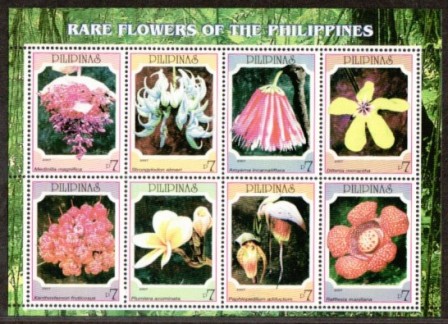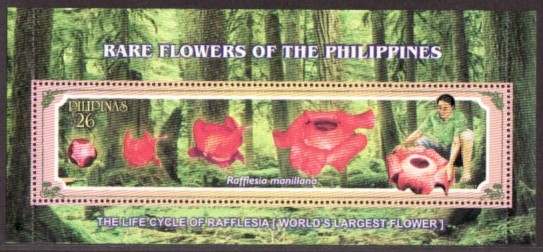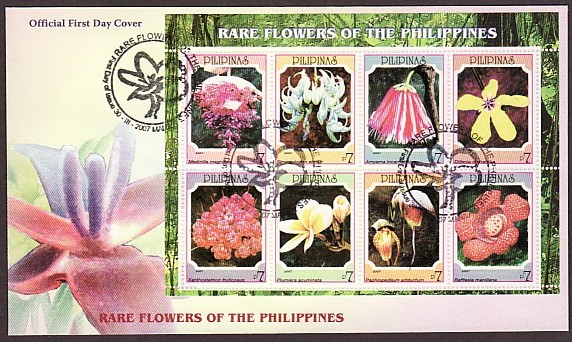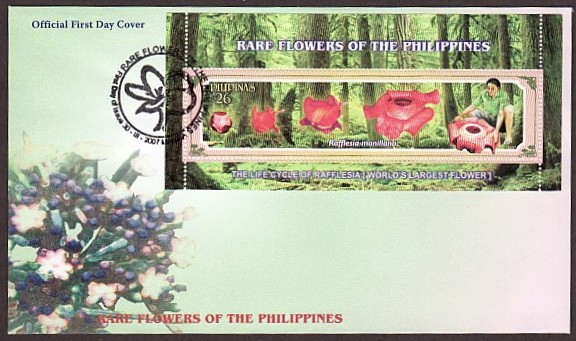2007, March 30 (May 29). Rare Flowers of the Philippines
Litho Offset. Amstar Company, Inc. Perf. 14.
Se-tenant Blocks of 8, Miniature Sheets of 8 (4 x 2); Souvenir Sheet of One


Miniature Sheets of 8 (35,000)
7p Medinilla magnifica
7p Strongylodon eimeri
7p Amyema incarnatiflora
7p Dillenia monantha
7p Xanthostemon fructicosus
7p Plumiera acuminata
7p Pahiopedilum adductum
7p Rafflessia manillana
Souvenir Sheets of 1 (8,000)
26p The Life Cycle of Rafflesia (World's largest flower)
Designers: Vic Cerevo, Jesus "Pidoy" de los Santos
Graphic Designer: Richard Allen Baron
Design Coordinator: Dr. Ngo Tiong Tak
Rare Flowers of the Philippines provided by Parks and Wildlife Bureau (PAWB)
First Day Covers: Manila

RARE FLOWERS FROM THE PHILIPPINES
Medinilla magnifica. Commonly called rose grape belonging to the family of plants called Melastomataceae Juss., this shrub is a stunning flower endemic to the Philippines. It is usually found in high altitudes growing up to 6 feet. The shrub has either ribbed or winged stem and glossy green leaves with conspicuously pale veins. The flowers are breathtaking growing as a bunch of small pink clusters attached to large pink bracts sheltered by its
curved leaves.
Strongylodon elmeri. Endemic in the thick forests of the country, this specie along with its more famous cousin Strongylodon macrobotrys (jade vine) are arguably the most beautiful flowers in the world. Strongylodon elmeri is a perennial climbing shrub belonging to the family Fabaceae. The flowers hang in bunches up to 90 cm and each with a spectacular clawlike shape measures up 7.5 cm. Bats usually pollinate these flowers.
Amyema incarnatiflora. Belonging to the family of Lorantacae, this particular specie calls the mountainous region of Cabadbaran in Agusan del Norte as well as the thick jungles of Cagayan province as its home. The bunch of slender pink flowers is a beauty forming a shape of a half open parasol.
Dillenia monantha. This specie is unique to the Philippines and produces only a single flower. Monantha after all is derived from the Greek words mono (one) and anthos (flower). The richly hued yellow flower is a spectacular sight thanks largely to the bottom colors that resemble a spider.
Xanthostemon fructicosus. Belonging to the family called Myrtaceae, this specie can call 3,000 other species as its close kin; many of them grow in Australia as well as in Mediterranean and America. This particular specie can be set apart, however, by its spectacular foliage that comes in red bunches of individual actinomorphous (spreading symmetrically) flowers.
Plumiera acuminate. Generally found in the tropics, Plumiera acuminate (sometimes known as Plumeria rubra and Plumeria acutifolia) is specie of Frangipani otherwise locally known as kalachuchi. Frangipanis are known to have eight (8) species found in tropical Americas; South and Southeast Asia and the Pacific Islands. With white and yellow colors, Plumiera acuminata is more closely identified with the common frangipanis. The flowers are very fragrant and a source of scent for perfumes. They have no nectars but scent lure potential pollinators that would go from flower to flower searching for food in vain but transferring the pollens in the process.
Pahiopedilum adductum. A member of the Orchidaceae family and is endemic to the Philippines. Usually found in tropical moist lowland forest, the scientific name is derived from the fact that it belongs to the family of orchids and that the shape of its staminode (vestigial stamen) is severely adducted that is severely bent backwards.
Rafflessia manillana. The scientific name of this specie is derived from its genus rafflesia (named after Sir Stamford Raffles, founder of Singapore, who first obtained a specimen) and from the city of Manila. Although Rafflesias can be found in various forests in Southeast Asia, this particular specie is the world's largest and endemic. It has a foul-smelling flower and is pollinated by carrion flies.
-
Flowers
